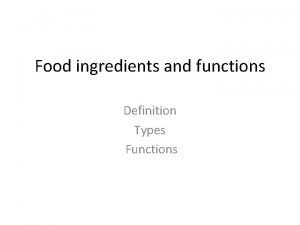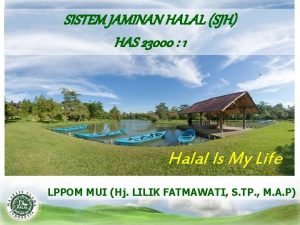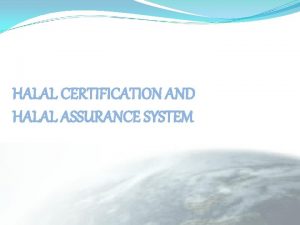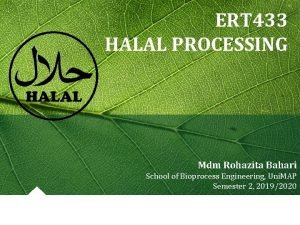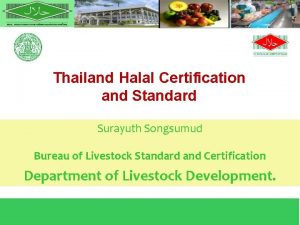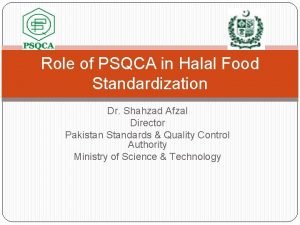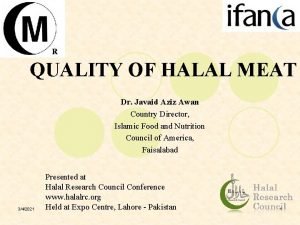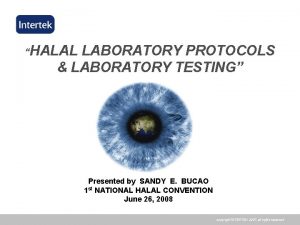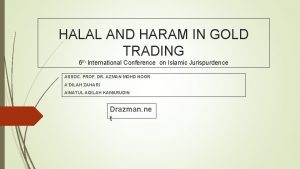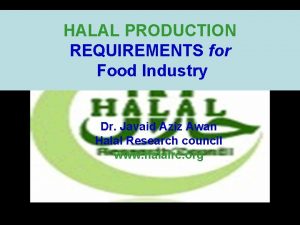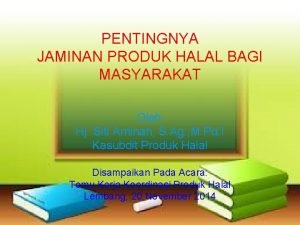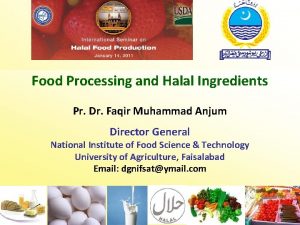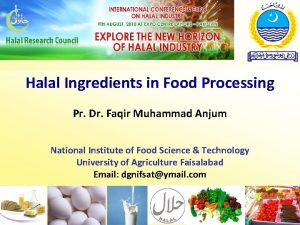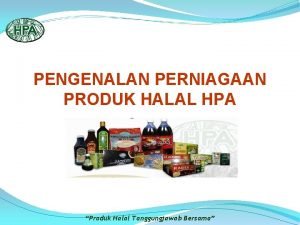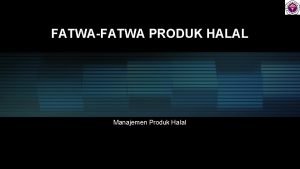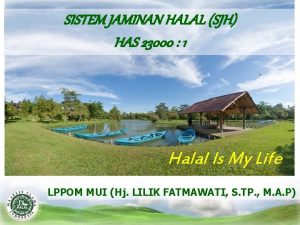Halal Ingredients in Food Processing Pr Dr Faqir































- Slides: 31

Halal Ingredients in Food Processing Pr. Dr. Faqir Muhammad Anjum National Institute of Food Science & Technology University of Agriculture Faisalabad Email: dgnifsat@ymail. com

ROAD MAP • Food Processing • Food Ingredients Sources • Halal Ingredients • Haram Ingredients • Questionable/Mashbooh Ingredients • E-codes • Requirements for Halal Food Processing National Institute of Food Science & Technology

Food Processing National Institute of Food Science & Technology

Food Processing Set of methods and techniques used to transform raw ingredients into food or to transform food into other forms for consumption by humans or animals either in the home or by the food industry. National Institute of Food Science & Technology

Aims of Food Processing • Have safe and sure food products • Isolate specific compounds and exploit the biological potential of constituents • To improve safety and freshness of products • Improve and control the functionality of food constituents Food Processing • Increase the storage life of food products • Development of traditional and innovative food products • To improve or maintain nutritional values • Keep quality and typicity of food products National Institute of Food Science & Technology

Methods used for Food Conservation Processing and conservation improved by an adapted packaging (sterile, impenetrable to water, etc. ) • Methods using coldness • Refrigeration • Freezing • Methods using heating • Pasteurisation • Sterilisation • UHT processing • Methods by dessiccation • Concentration (liquid food like milk) • Drying • Other methods • Filtration • High pressure • Ultra-sounds • Pulsed electrical fields

Food Ingredients Sources National Institute of Food Science & Technology

Food Ingredients Sources • Animals (Milk, Eggs, Meat, Seafood) • Plants (Fruits, Vegetables, Spices, Seafood) • Synthetic (Flavours, Colours, Additives) • Fermented (Organic acids, Cultures, Enzymes) National Institute of Food Science & Technology

Groups of Food Ingredients-1 Preservatives Sweeteners Color additives Flavors, Spices Flavor enhancers Fat replacers Nutrients Emulsifiers Stabilizers, Thickeners, Binders, Texturizers

Groups of Food Ingredients-2 Leavening agents Anti-caking agents Humectants Yeast nutrients Dough strengtheners, Conditioners Firming agents Enzyme preparations Gases

Halal Ingredients National Institute of Food Science & Technology

Halal Ingredients-1 • Only ALLAH, the Supreme Law Giver can ordain what is Halal and what is Haram • Halal food means food fit for human consumption and permitted by laws of Islam or permissible and lawful • The food or its ingredients do not contain any parts or products of animals that are non-Halal or products of animals which are not slaughtered according to Laws of Islam National Institute of Food Science & Technology

Halal Ingredients-2 • Halal ingredients must not be Najis • Halal ingredients must safe and not harmful • Halal ingredients are neither prepared, processed or manufactured using Najis equipments nor remained in contact with Najis items National Institute of Food Science & Technology

Sources of Halal Ingredients • Vegetable ingredients All Halal except intoxicating • Animal derived ingredients Animals must be of the Halal species Halal animals slaughtered by sane Muslim Ensure complete removal of blood from carcass Humane handling to be practiced • Synthetic ingredients: All Halal National Institute of Food Science & Technology

Haram Ingredients National Institute of Food Science & Technology

Haram Ingredients • Haram Foods means foods or drinks strictly prohibited by Quran and Sunnah • Haram foods include those containing: • Pork • Alcohol • Blood • Dead animals • Animals slaughtered without reciting the name of ALLAH National Institute of Food Science & Technology

Questionable/Mashbooh Ingredients National Institute of Food Science & Technology

Questionable/Mashbooh Ingredients Mashbooh is an Arabic term means suspected or doubtful ingredient about which we are not sure of the source • Gelatin: Pork, Beef, Fish • Glycerin/glycerol: Saponification of animal fats • Emulsifiers: Animals • Enzymes: Animal, Microbial, Biotechnological • Dairy Ingredients: whey, cheese • Alcoholic Drinks • Animal Protein/Fat • Flavorings and Compound Mixtures National Institute of Food Science & Technology

Other Examples • Taurine: Often used in energy drinks, mostly derived from pig gall • Pepsin, clarifiers and stabilizers: to make drinks look clear • Cloudifiers: to make juice look cloudy • Active carbon and flavors: for fruity aromas National Institute of Food Science & Technology

GMO’s Biotechnology • Chemicals acceptable • Enzymes acceptable • Transgenic Foods • Plant to plant gene transfer is ok • Animal to plant gene transfer? • Animal to animal gene transfer? • New Species? National Institute of Food Science & Technology

E-Codes National Institute of Food Science & Technology

E-Codes • E-codes are codes sometimes found on food labels in the European Union (Great Britain, France, Germany, Spain, Italy, Portugal etc. ) • The codes indicates an ingredient which is some type of food additives • The “E” indicates that is a “European Union Approved” food additive • Other countries have different food labeling laws National Institute of Food Science & Technology

E-Codes Groups E-Codes number E-100 E-200 E-300 E-400 E-500 E-600 Groups of Food Ingredients Coloring agents Preservatives Anti-oxidants Thickeners, Stabilizers, Gelling agents, Emulsifiers Agents for physical characteristics Flavor enhancers National Institute of Food Science & Technology

E-Codes Groups E-Codes number Groups of Food Ingredients E-900 Glazing agents, Improving agents E-1100 Stabilizers, Preservatives E-1200 Stabilizers E-1400 Thickening agents E-1500 Humectants National Institute of Food Science & Technology

Some Examples of Mashbooh and Haram E-Codes E-No E-106 E-120 E-140 E-161 b E-252 E-304 E-322 E-431 Food Ingredients Riboflavin 5 -Sodium phosphate Cochineal, Carmines (Animal) Chlorophylls, Chlorophyllins Lutein Potassium nitrate, Saltpetre Fatty acid esters of Ascorbic acid Lecithin from animal fat Polyoxyethylene Mashbooh/Haram Mashbooh Haram National Institute of Food Science & Technology

Requirements for Halal Food Processing National Institute of Food Science & Technology

Requirements for Halal Food Processing • Ingredients must be from Halal source • Processing must be checked according to Islamic rules and regulations • Final compositions must be checked if there is involvement of any alcoholic product during processing • In final composition alcoholic ingredients must not exceed than the permissible limits • Packaging material should not contain any haram ingredient • Cross-contamination must be avoided • Equipments must be washed with permissible detergents National Institute of Food Science & Technology

Sanitation & Cross-Contamination • In Food Processing, all equipment must be clean per visual/laboratory inspection – Clean up after non Halal Ingredients production (if both are being processed with the same equipment) • All Halal products must be segregated during storage to avoid cross-contamination National Institute of Food Science & Technology

Halal Market • Halal, ethnic & specialty stores • Supermarket chains • Food Services – Universities – Schools – Offices – Prison systems – Airlines – Armed Forces National Institute of Food Science & Technology

Importance and Advantages of Halal Monogram on the Processed Product • Doubt clarification • Time saving (reading the labels) • Peace of mind and satisfaction National Institute of Food Science & Technology

THANKS FOR YOUR ATTENTION QUESTIONS www. halalrc. org National Institute of Food Science & Technology
 What are the functions of food analogs?
What are the functions of food analogs? Enzymes in food
Enzymes in food Ingredient definition
Ingredient definition Unit 2 food food food
Unit 2 food food food Food chain sequence
Food chain sequence Sistem jaminan halal has 23000 pdf
Sistem jaminan halal has 23000 pdf Halal training program
Halal training program Halal assurance system manual philippines
Halal assurance system manual philippines Halal meaning
Halal meaning Peta konsep makanan halal
Peta konsep makanan halal International halal integrity alliance
International halal integrity alliance Thailand halal logo
Thailand halal logo Psqca
Psqca Javaid aziz
Javaid aziz Halal meaning
Halal meaning Halal guidance test
Halal guidance test Contoh daftar riwayat hidup penyelia halal
Contoh daftar riwayat hidup penyelia halal Indonesia halal certification
Indonesia halal certification Gold investment halal or haram
Gold investment halal or haram Gcc accreditation center
Gcc accreditation center Contoh bahan kritis dengan sh
Contoh bahan kritis dengan sh Reward income
Reward income Kepentingan bersuci terhadap alam sekitar
Kepentingan bersuci terhadap alam sekitar Haldoklás szakaszai
Haldoklás szakaszai Ethyl alcohol halal
Ethyl alcohol halal Bob haram
Bob haram Halal declaration letter
Halal declaration letter Tiara tv
Tiara tv Halal
Halal Kma 464 tahun 2020
Kma 464 tahun 2020 Pentingnya produk halal
Pentingnya produk halal Sacrificio sinonimo
Sacrificio sinonimo


